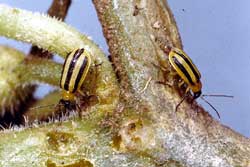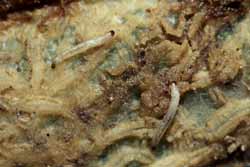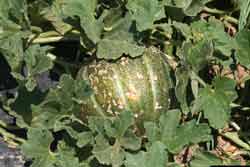Striped Cucumber Beetle—Acalymma vittatum
Striped cucumber beetle adults feed on the foliage and stems of cucurbits all season long. They often girdle stems by gnawing on the tender shoots of seedlings; they later feed on the leaves, vines and fruits of plants that survive. Sometimes, deep pits are gnawed into the rind, making the produce unfit for consumption or market. Adult cucumber beetles harbor bacterial wilt organism (Pseudomonas lachrymans) in winter and transmit it during the growing season. They also help spread squash mosaic virus.
Larvae injure plants by feeding on roots and tunneling through stems, weakening the plant and making it susceptible to other problems. Striped cucumber beetles prefer cucumber, cantaloupes, winter squash, pumpkin, gourd, summer squash and watermelon but also feed on bean, pea, corn, and the blossoms of several wild and cultivated plants.
Click on images to view full-size
Identification and Control Information
- Pest Management Fact Sheet: Striped Cucumber Beetle—University of Maine Cooperative Extension
- Fact Sheet: Striped Cucumber Beetle (PDF)—University of New Hampshire Cooperative Extension
- Fact Sheet: Striped Cucumber Beetle (PDF)—Insect Diagnostic Laboratory, Cornell University
- Garden Facts: Cucumber Beetles (PDF)—University of Wisconsin Extension
- Tips for Managing Striped Cucumber Beetles (PDF)—Maine Integrated Pest Management Council
[Photos, left to right: Clemson University - USDA Cooperative Extension Slide Series, Bugwood.org; Whitney Cranshaw, Colorado State University, Bugwood.org; Whitney Cranshaw, Colorado State University, Bugwood.org]


